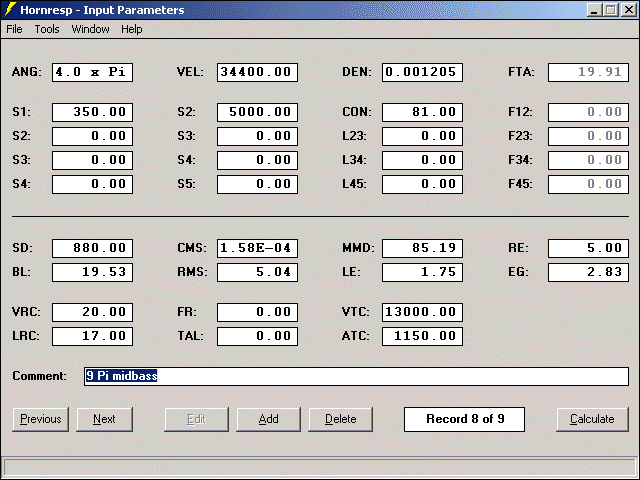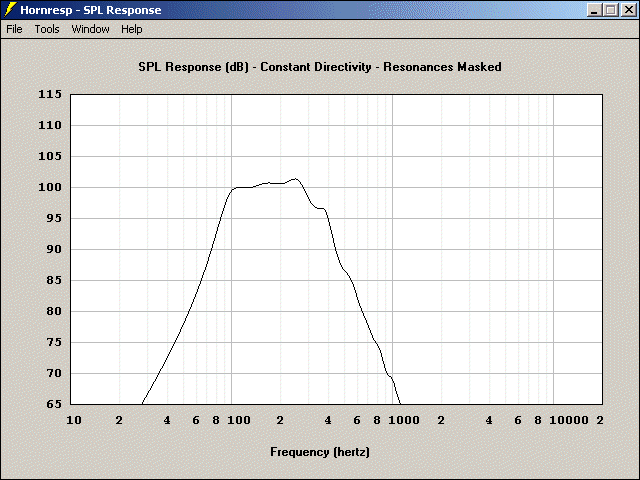| Horns in groups, radiating into constrained space and room modes [message #51357 is a reply to message #51354] |
Mon, 20 August 2007 09:18   |
 |
 Wayne Parham
Wayne Parham
Messages: 18689
Registered: January 2001
|
Illuminati (33rd Degree) |
|
|
You can certainly make horns smaller that will be used in groups or boundary loaded. Making them smaller on this assumption makes stand-alone use not an option though.
Have you played around with Hornresp yet? It looks a little bit intimidating at first, but once you've modeled a horn with it, it becomes very easy to use. You'll appreciate using it to test your ideas before making a prototype. Helps to narrow down your choices with it.
The difference between a folded horn placed in a trihedral corner and a direct radiator placed in a corner depends entirely on the characteristics of each. However, assuming both are placed within 1/4λ from the apex, then both are radiating into eighth space.
Corner loading for basshorns acts something like a mouth extension. Response is made smoother and on-axis sensitivity is increased, at least at low frequencies. Horns usually provide directional control, but to what extent depends on the horn's size and shape. At low frequencies, the horn usually isn't big enough to provide any directional control but at higher frequencies, it is. So the corner provides directional control at the lowest frequencies where the basshorn can't.
The net result is on-axis sensitivity is increased 9dB at very low frequencies, but less as frequency rises. This is because the horn is acoustically small at deep bass frequencies but it becomes acoustically large at some point higher in frequency. At the lowest frequencies, the corner is providing directional control, narrowing the radiating angle and increasing on-axis sensitivity as a result. Higher up, the horn is providing directional control and the corner has less influence, if any at all.
Just like a basshorn, placing a direct radiating woofer within 1/4λ from the apex of a trihedral corner raises its on-axis sensitivity. The alignment of the cabinet should be slightly overdamped because this will work best for corner loading. What you get is 9dB sensitivity increase. The corner provides directional control for the direct radiator the same way it does for the basshorn. At very low frequencies, the corner is probably the only feature acoustically large, so it is the only thing that has any effect.
Whether a horn or a direct radiator is corner loaded, the room has other features that setup standing waves inside of it. If the trihedral corner were open, you could expect it to provide perfect pattern control down to the deepest frequencies. But the opposing walls create reflections and standing waves are a result. This creates nodes of high and low energy spots within the room. No matter where you place a woofer, this is true. But the point I want to make is that radiating from a trihedral angle provides a specific coverage pattern but room modes modify that a great deal. You can use a program like CARA to model room modes.
|
|
|
|
|
|
|
|
| Using Hornresp to model a midbass horn [message #51361 is a reply to message #51358] |
Mon, 20 August 2007 10:15   |
 |
 Wayne Parham
Wayne Parham
Messages: 18689
Registered: January 2001
|
Illuminati (33rd Degree) |
|
|
Let's do it together. First, download a copy of Hornresp. We can use the 9π midbass horn as a starting point, and modify values as needed to reflect what your horn will look like.
Look at the midbass horn used in the 9π. Remember that it uses a JBL 2226 and has a 20° wall angle for total coverage angle of 40°. The length is 32", mouth dimensions are 28" x 28", throat is 7.5" x 7.5", front chamber is 800in3 and rear chamber is 1200in3. It was designed to operate in free space.

9 π Midbass Hornresp input screen

9 π Midbass SPL response
Now then, for your horn, you'll want to modify the electro-mechanical parameters at the lower section of the input screen. Those shown are for the JBL 2226 and you'll want to enter values for your 2206. It's pretty easy to do.
Enter the surface area of the cone in Sd. Enter the DC resistance of the voice coil in Re and the voice coil inductance in Le. Le is actually non-linear and so a single figure doesn't really mean much but that's another story. It won't matter much for what we're doing here. Both Re and Le are listed on the product spec sheet so just enter those values.
Double click on Cms and it will ask for Vas. Double click on Rms and it will ask for Fts and Qms. Double click on Mmd and it will ask for Fts. Double click on Bl and it will ask for Fts and Qes. Do each of these in order.
Once you've done that, you've entered the electro-mechanical parameters for your woofer.
Now the fun starts. Play around with the throat area, front chamber volume and rear chamber volume first. Throat area is S1, front chamber volume is Vtc and rear chamber volume is Vrc. Vrc has to be entered in liters and Vtc has to be entered in cubic centimeters. So pay attention to that when entering. Also, pay attention to the Atc and Lrc values. Atc is the average cross-section area of the front chamber in cm2 and Lrc is the average length of the rear chamber in centimeters. Just pick values that are reasonable. They don't usually matter unless you pick something that's way out of whack.
You can also play around with the size and shape of the horn. Make the mouth area smaller, if you like, by changing the value of S2. You can change horn length by changing the value of CON You can add another section if you like, perhaps widening the flare near the mouth. Enter values for S3 and L23 to do that. Consult the "help" section in Hornresp if you need more information about it.
After you've started getting a hang of this, change the radiating angle from freespace to something a little more constrained, to see how that affects response. Try halfspace, quarter space and free space. Try an infinite horn. Freespace is 4π, half space is 2π, quarter space is π, eight space is π/2 and infinite horn is 0.
The more constrained you make the radiating angle, the smoother the response becomes. An infinite horn is a good approximation of what happens when you have a large number of horns used together. It's like a limit, or what response will approach for a given horn in best case environment.
It's really not that hard to model a basshorn or midbass horn like this. They're typically pretty simple, made from one or more straight sections which are accurately and easily entered into Hornresp. It does a good job of predicting response of basshorns, so you can trust it to tell you what you want to know.
|
|
|
|
|
|







